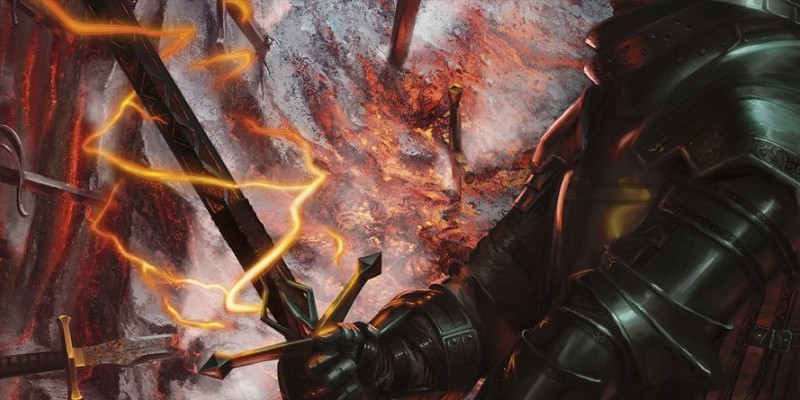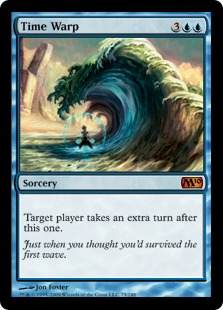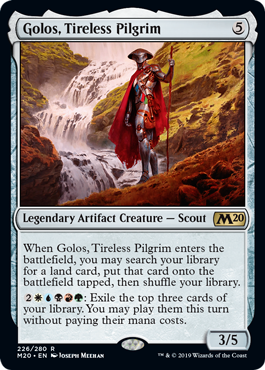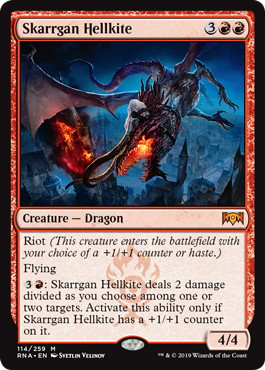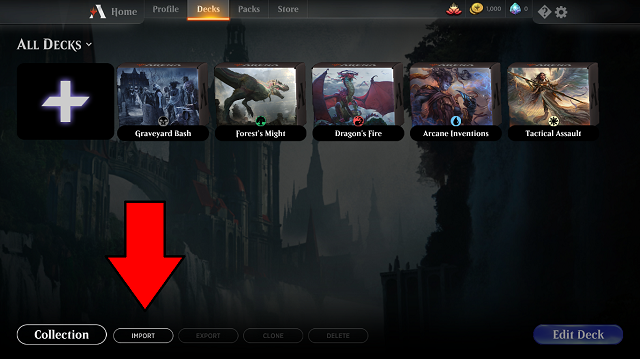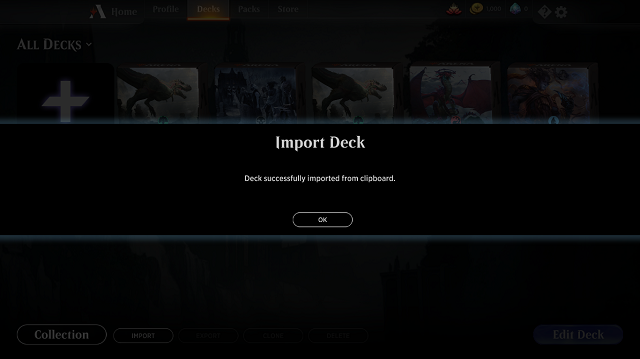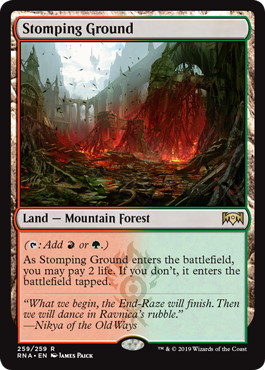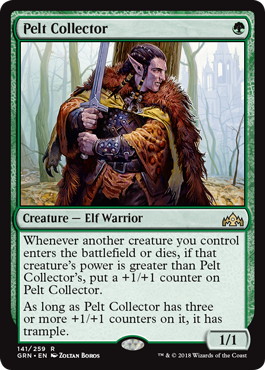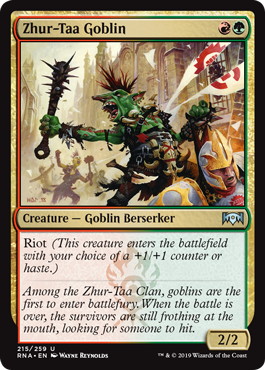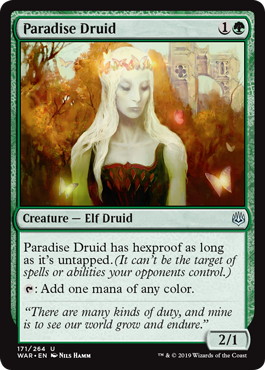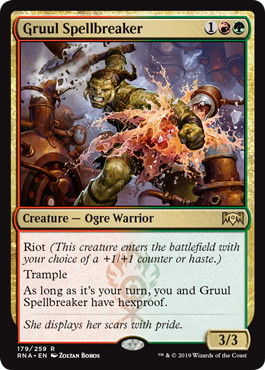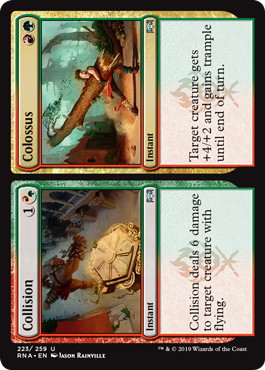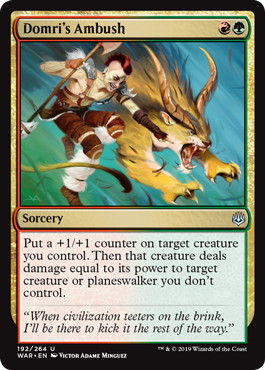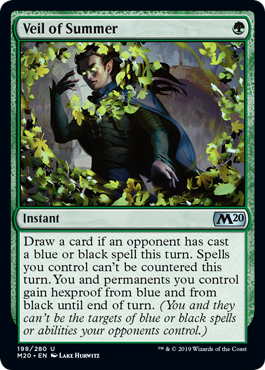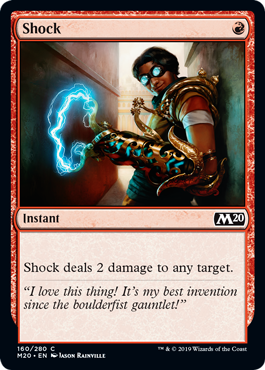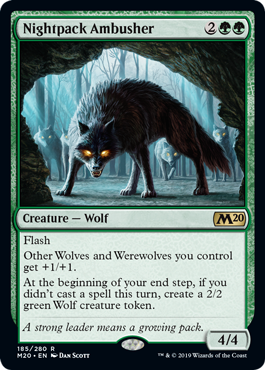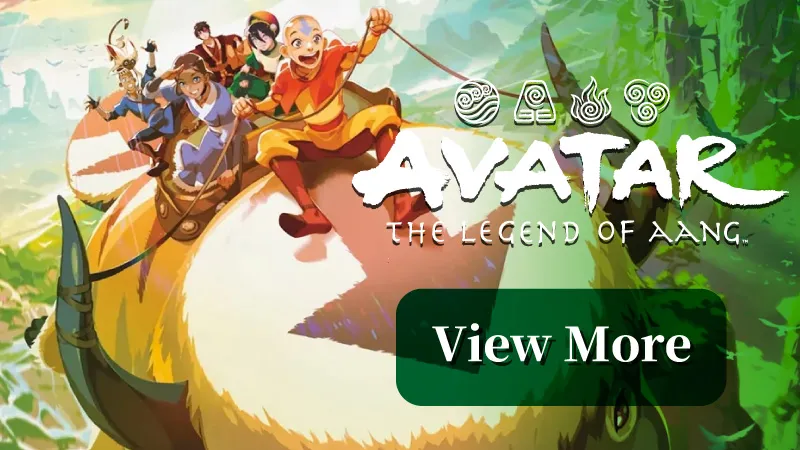Introduction
Hola!
Sometimes, when you compete in a tournament, you leave the venue feeling like there wasn’t that much you could have done to avoid losing. It just feels like it wasn’t your day. The opposite can also happen, and that’s how last weekend on the Mythic Championship V felt to me.
Preparation
I prepared this tournament with the following group: Andrea Mengucci, Lee Shi Tian, Carlos Romao, Lucas Esper Berthoud, Marcio Carvalho, Antonhy Lee and Beatriz Grancha. Only the 6 of us playing on the tournament, with the following deck split: 2 Bant Golos, 2 Bant Food and 2 aggressive decks (Mono-Red and Gruul).
Deckbuilding time for this MC was similar to the old Pro Tour’s one, happening around two weeks after a set release. For those who were not around, those Pro Tours/MCs took the name of the released set as their own (i.e Pro Tour Theros), so this clearly felt like “Mythic Championship Throne of Eldraine”. For this event, we had a little bit less than two weeks to submit our decks once Throne of Eldraine was released on MTG Arena.
If you make the numbers, you will see that we actually had to submit our decklists about 9 days before the tournament started. Things work this way so they can make sure everything functions properly for the event. Having so little time, all the MCV competitors were very dedicated to the deckbuilding race to find the best deck.
However, things are very different now to what they used to be a few years ago. Nowadays, information spreads incredibly fast and instead of having an unknown metagame where you could expect a few teams to “break it”, we had a metagame with a clear deck to beat: Bant Golos. There must have been a few different reasons for this to happen, but I assume that the huge amount of Magic games going on nowadays and how well connected the Magic community is must be two of the biggest factors.
If you frequently read my articles, you would’ve expected me to be one of the Golos Field players, and that was indeed my plan. The weekend before the deck submission, I played Bant Golos on the MOCS Playoff to a Top8 finish. Playoffs are tough tournaments and most of my opponents were actually very good at playing Standard, so that Top8 reinforced my good feeling with the deck.
The more I played with Golos the better I thought it was in terms of power level but also the weaker I felt against decks specifically trying to beat it. Golos was an excellent deck, but the problem I found was that most decks were already well tuned against Golos. Slowly, good matchups became just fine matchups, but the bad ones kept being as bad as they were before.
Particularly, hyper-aggressive decks were extremely problematic and the only defense I really had was the fact that they were very weak against any deck playing 《Oko, Thief of Crowns》.
My conclusion was that Oko was the reason why Golos was good, since it just made all the Golos-predator decks a little bit awkward to be played, since every card you changed to make your deck good against Golos would be embarrasing against Oko decks.
About 2 days before the deadline, I started being really worried about Oko decks getting too much adapted to beat Golos that I started to search for an alternative. My expected metagame was roughly 50% Golos among the high tables of the tournament, so I thought playing some kind of suicidal anti-Golos deck could pay off.
After playing so much with Golos I was well aware of most of its weaknesses. Haste creatures were annoying, direct damage was annoying and flying creatures were relatively problematic, but there was one card I was virtually never able to beat:
With that idea in mind I decided giving a try to Gruul, since most of the times I faced 《Embercleave》 meant I was facing a Gruul deck.
My first encounters with the deck were rather disappointing. Manabase wasn’t good and there were many cards that really didn’t go very well with my plan of just playing haste creatures and dealing damage as fast as possible.
After that I decided to give Gruul one last try before giving up. However, I applied a lesson learnt from Bant Golos:
《Once Upon a Time》 is broken.
I had in front of me a deck that had a bad manabase and REALLY wanted to have a 《Pelt Collector》 on turn 1. 《Once Upon a Time》 (OUAT) helped in both aspects. I gave it a try and I started with few copies. After a couple of games, I was completely sure I wanted to play 4 copies in the archetype since it just made the deck function much better. Not only it just made mulliganing better, but it also made it easier to have the strongest draws, which was also a way to fix bad matchups.
Since I was trying to specifically prey on Golos, I made sure all my 60 maindeck cards were at least decent in the matchup. That meant no 《Domri’s Ambush》 or any Domri card for that reason. It also meant all my punching creatures needed to get through 《Arboreal Grazer》. It took me many matches on the ladder to finally face a Bant Golos deck, but when I did, I played against 4 in a row and Gruul really delivered.
So, I had a deck that was good against Golos, which made sense since I had literally built the deck because it was very good against it and also converted it into a post-boarded version against Bant Golos.
However, in this testing process I realized something that eventually was the biggest reason why I ended playing Gruul at the MCV: Gruul was organically good against decks designed specifically to beat Golos. Traditionally, the best way to beat a deck that tries to go over the top of everyone is simply going under, and this was no different. However, finding out that cards like 《Gruul Spellbreaker》 and 《Skarrgan Hellkite》 could have a dual role (offensive-defensive) was a pleasant surprise. Most aggro decks really struggle dealing with a 5/5 fire-shooting dragon.
Time was running out and I really had two options; Golos or Gruul. At the end I decided that Golos + Anti-Golos decks would likely be enough share of the metagame to make Gruul an acceptable choice. Also, powered by OUAT I felt like the deck was reasonably good at curving out, which sets a ground on how often you can beat a bad a matchup.
One upside I didn’t take into consideration when I decided to play Gruul was how much fun my teammates would have trolling me about my deck of choice. That was free value!
Mythic Championship V
Day 1
Heading into day 1 I wasn’t very happy about my deck choice since there were lots of Food decks I would have to avoid, since I had decided to attack Golos instead of Food with my deckbuilding decisions.
My plan didn’t go very well as I faced Mengucci on the first round who quickly destroyed me. After meeting another Food deck in hands of Yuuki Ichikawa I was quickly 0-2 with my back against the wall. Starting 0-2 also means you usually have bad tiebreakers so from my perspective I would probably need to win the next 5 rounds to stay alive in the tournament. After a good run including a mirror match I ended being 4-2 before I played my win and in against the constructed master Sebastian Pozzo on Golos. It was a good matchup, but the match itself didn’t go very well for me and Pozzo took the win. With a little bit of luck I sneaked on 23th place out of 24th into the day 2, where standings would reset. Day 1 already was quite the roller coaster, but it ended well.
Day 2
Day 2 started with a win against MPL competitor Autumn Burchett and then a loss to (again) Simic Food in hands of Chris Kvartek. After that I beat Lee Shi Tian and Ken Yukuhiro both playing aggro to put myself 3-1 and in a good position to make Top8.
Next opponent was, similarly to what happened in London, Seth Manfield on Golos. While Golos was my best matchup, I simply believe one should never be too happy to be playing against Seth or someone of his level in a tournament.
– A Little Input on Matchups/Players –
My good friend Zen Takahashi once pointed out that Seth Manfield is likely the best Dredge player in the world and likely the best Burn player too. From my perspective, Magic is about two players playing a game and not only two decks playing each other. I usually put more weight on who I’m playing against than on which deck they are playing, because I think the in-game decisions in Magic matter a lot, as well as deckbuilding decisions that can strongly impact a matchup as well.
My point of view in this matter is not that relevant during a tournament – after all, you can’t choose who you get paired against during a tournament – but I’ve thought for a long time that this concept is wildly underrated by many competitive players. Certain matchups can play out in different ways against different opponents, so it can be correct in some situations to make some deckbuilding concessions towards this concept.
– Back to the Tournament –
In reality, my win % of that matchup is likely the biggest I’ve had against a top player in a tournament like an MC, so the situation was still a good one compared to playing any other matchup. On the actual match, Seth’s deck didn’t function at all and suddenly I was 4-1 and in a good shape to make Top8 at the MC, since I would have two win and in matches.
On my first win and in I faced my roommate Mengucci again on Bant Food, who farmed me again and reached his Top8.
For the second win and in I was really hoping to play against Golos again… but I got paired against Hall of Famer Gabriel Nassif on Simic Food, quite a bad matchup. After two intense games, I lost my win and in… except I sneaked on 8th place on breakers, being the only player with 4-3 to get there, so It wasn’t exactly my win and in.
Now, for someone that has already been 9th place twice in PTs with tight tiebreak spots, this felt extremely lucky. The second I realized I had made it on breakers was just a huge rush and some minutes later the Top8 was announced.
Completely exhausted, I went to have dinner with Lee Shi Tian and Mengucci and we were very happy since we all 3 had made Top8. Looking at the bracket and how the matchups were, we concluded that for me and Lee winning was extremely unlikely, but Mengu actually had a decent chance.
Day 3
I think all the Day 3 games were actually recorded on camera so I won’t really go into much detail there. My first two matches were against Food decks and I finally got to win that matchup thanks to some lucky draws. After that, I played against Jean-Emmanuel Depraz on Golos where I also won putting myself 3-0. That meant I would have to win one match out of two on the finals.
After beating Mengu, Depraz was my opponent on the actual finals of the tournament. It was, again, Golos, my best matchup but Depraz is a very tough opponent who actually prepared a very good sideboard plan against my deck, so I knew things could get complicated. And they did. Depraz took the first match and after a small break we played the 2nd match of the finals, where the winner would win the tournament.
At the end, it just came down the one final game where I was on the play and the powerful 《Embercleave》 decided to show up. A few minutes later, I became the Mythic Championship V winner.
After the initial burst of joy, I couldn’t believe it. Everything that could have come my way simply did so, and I won the tournament even if the bracket matchups were looking quite bad for my chances.
I felt good.
I got asked a few times how did it feel to win a MC after winning Worlds. I will never know how would had felt if I hadn’t won Worlds before, but I can tell you winning this tournament was a very intense experience to me. I don’t really know if someone can get used to that, but I guess we would have to ask Kai Budde.
For me, I just couldn’t keep asking to myself: is this real?
Apparently it was real, and that’s how this article was born.
Once again I’d like to really thank everyone that showed me support and helped on my way there. Every single situation like this keeps feeling like once in a lifetime experience and I could not get there without the help and support of many awesome people I’ve met along this path.
FERVENT CHAMPION #GRUUL #MythicChampionshipV pic.twitter.com/OMmQqD6kXR
— Javier Domínguez "Thalai" (@JavierDmagic) October 21, 2019
GRUUL!
- Javier Dominguez
- – GRUUL
- Mythic Championship V
- (Champion)
9 《Mountain》
4 《Stomping Ground》
-Land (23)- 4 《Pelt Collector》
4 《Zhur-Taa Goblin》
3 《Paradise Druid》
2 《Kraul Harpooner》
4 《Gruul Spellbreaker》
4 《Bonecrusher Giant》
4 《Questing Beast》
3 《Skarrgan Hellkite》
-Creature (28)-
3 《Domri’s Ambush》
2 《Thrashing Brontodon》
2 《Redcap Melee》
2 《Shock》
2 《Veil of Summer》
1 《Shifting Ceratops》
-Sideboard (15)-
I’ve talked a little bit about how I came to the conclusion to play Gruul and now I want to talk a little bit about how it functions. With the banning of 《Field of the Dead》 the metagame is going to change, but most of the concepts of the deck will still stay around.
The deck works as a curve out deck. That means hands that do not accomplish that goal are usually mulligans even if they have a fine mix of lands and spells. In other words, your cards are going to be worse than your opponent’s unless you play them on curve.
Gruul’s manabase has always been a problematic point and it didn’t get much better now except for OUAT. We only have access to one dual land in the form of 《Stomping Ground》 and since the deck wants to use its mana every turn, lands that come into play tapped like 《Fabled Passage》 were really underwhelming for me.
《Pelt Collector》
《Pelt Collector》 is the most important card to curve out with and the most important creature in our deck. 《Pelt Collector》 is the card we always want to have on turn 1 and most functional hands that include this card will probably be a keep. I think 《Pelt Collector》 on the play followed by a good curve is very hard to stop. 4 copies + 4 OUAT gives us a decent chance to drop a Collector on turn 1 while keeping a low count of 1 drops in the deck, which mainly improves our average topdeck quality.
《Zhur-Taa Goblin》
Even though it looks like a mediocre filler, I actually think 《Zhur-Taa Goblin》 is a fine card. At the end of the day, it is a better 《Watchwolf》 since the 2/2 haste mode actually matters a lot in this deck. We will default Riot as a +1/+1 counter most of the time, but situations like expecting a 《Deafening Clarion》 or our opponent being low on life will make the haste option more attractive.
《Kraul Harpooner》
I said if briefly, but I really wanted all my brawling creatures to be able to attack through 《Arboreal Grazer》. This rapidly ruled out cards like 《Robber of the Rich》 and 《Wildborn Preserver》 which were very underwhelming in my experience. Among the ones that could attack through an 《Arboreal Grazer》, Harpooner was the strongest one and snacking 《Gilded Goose》 is a very good factor going forward. I would likely move up to 4 Harpooners if Food becomes the most dominant deck.
《Paradise Druid》
《Paradise Druid》 is there to help with the consistency. Some games you are trying to rush a 1-2-3 mana curve, but sometimes things don’t work well and having the option to power a third turn 《Questing Beast》 is a fine backup plan. Card gets often sideboarded out and is never very good, but I was actually happy with how 《Paradise Druid》 filled the curve.
《Bonecrusher Giant》
《Bonecrusher Giant》 is virtually never involved in our best draws, but it can fill a spot in the curve if needed while never being completely dead. Surviving 《Realm-Cloaked Giant》 was a nice bonus, but even without that card seeing much play I think Bonecrusher is simply too good when it’s good but it is never too bad.
Keep in mind playing Giant on turn 3 without going through the Adventure mode is a common line in this deck.
《Gruul Spellbreaker》
《Gruul Spellbreaker》 is an incredible flexible card and most of the difficult decisions I faced during MCV were about this creature’s Riot ability. Haste is the default ability but many cards in both our deck and the whole format can make you want to go with a 4/4. 《Pelt Collector》, 《Embercleave》 or even a potential 《Oko, Thief of Crowns》 from our opponents are fine reasons to just play a “defensive” Spellbreaker.
《Questing Beast》
《Questing Beast》 is simply excellent in this deck. While I’m (was!) not exactly the biggest fan of 《Questing Beast》 it is very good at supporting what the deck is doing. For that reason, even multiple copies are fine since our opponents often just need to deal with the Beast as soon as possible. It makes playing cards like 《Teferi, Time Raveler》 against us not very appealing and also plays very well with 《Collision/Colossus》.
Ever had an 《Embercleave》 attached to a 《Questing Beast》? Gruul Combo!
《Skarrgan Hellkite》
《Skarrgan Hellkite》 is a card I really never loved during the testing process, but also identified it as a necessary evil for the deck to function. I was happy cutting the 4th copy since it was often a little bit too heavy, but there were just too many situations where all I needed was a big hasty dragon.
Hellkite was a fine attacker, but it really shined against other aggressive strategies, where a non-green 5/5 could simply avoid most removals like 《Noxious Grasp》 or 《Lava Coil》 often being almost unkillable for our opponents. 《Skarrgan Hellkite》 was one of my biggest overperformers in the MCV singlehandedly winning a couple of games. Remember you can also “wake up” the dragon with 《Domri’s Ambush》, since 《Skarrgan Hellkite》 doesn’t care about where the counters came from.
《Once Upon a Time》
Gruul doesn’t play many spells, but the ones that are in the deck are very important.
《Once Upon a Time》 is the best card in the deck and in contention for the best card in Standard. It’s also no coincidence that it was the most played card in the MCV as well. It might look like having multiple OUAT in this deck is a bad idea, but I strongly believe that’s not the case.
Gruul is trying to go 1-2-3-4 drop every game, and that involves a mix of 4 lands and every single spot on the curve covered. OUAT simply works as a joker card that can be any of those a reasonably high % of the time. 1 lander with OUAT? Easy Keep! A somewhat slow hand that needs a 1 drop to become the nuts with OUAT? Keep with a reasonable % of getting there! – and so goes on. Drawing OUAT midgame is not ideal, but it is still usually better than drawing random 1-2 drop that would likely have no impact in the game anymore, since OUAT can fetch the heavy hitters like 《Skarrgan Hellkite》.
I think OUAT is good enough that it might enable a few new decks by itself while it is legal in Standard.
《Collision/Colossus》
《Collision/Colossus》 was my choice of interaction for the tournament, since the card was never useless and can act as a removal if we force our opponent to block. It also plays well with huge creatures thanks to the trample ability. I think I would’ve likely still play a copy or two if 《Colossus》 alone was a card, but the ability to kill a huge 《Hydroid Krasis》 or a 《Gilded Goose》 on turn 2 gives the card extra flexibility.
Destroying a 《Skarrgan Hellkite》 in the mirror also came up to me.
《Embercleave》
《Embercleave》 was relatively absent during the first stages of the tournament but luckily it decided to show up at the right time. I’m not sure if three would’ve been a better number, but I think it is worth testing, since there aren’t that many decks that can survive the first one. Drawing two is too bad so it is not very clear.
What 《Embercleave》 does well is turning your good hands into unbeatable ones, but doesn’t really help you much at developing the game, which often makes it awkward against aggressive strategies. If the metagame becomes more defensive with more planeswalkers, 《Embercleave》 will be stronger.
Sideboard Guide
Hello! Welcome to the GRUUL Sideboard Guide.
Gruul functions a little bit like a proactive Modern deck, meaning that I just really didn’t want to sideboard much unless I wanted to just become a whole different deck.
Golos (Banned)
No Changes. Yep.
Food Decks

Against Food Decks
Our matchup against Food is not good, but making it better is about replacing some creatures for others that are more appropriate against their deck. The deck could also use a 4th 《Domri’s Ambush》 or even have a copy or two in the maindeck if the metagame asks for it. I don’t think 《Domri’s Ambush》 is a very good overall, but when it’s good, it’s very good. Remember it can deal with planeswalkers and drawing two copies is often a massive swing even against cards like 《Nissa, Who Shakes the World》.
Control Decks (with Sweepers)

Against Control Decks (with Sweepers)
Then again, we don’t really want to change our plan so we don’t sideboard much. If our opponent is playing 《Deafening Clarion》 or 《Fires of Invention》, 《Thrashing Brontodon》 is better than other fillers like 《Bonecrusher Giant》.
Golgari Adventures

Against Golgari Adventures
We want to reinforce the interaction and I like to keep a 《Colossus》 or two since it deals well with 《Lovestruck Beast》.
Aggro
Against aggressive strategies it really depends on what they are trying to do. If you think they have too many ways to deal with your creatures, you always have the option to transform into a bigger midrange deck. Of course, there are going to be some aggressive matchups where we will want to have cards like 《Collision/Colossus》 or 《Kraul Harpooner》, but those instances should be relatively obvious. Remember 《Shock》 is not necessarily good against all the aggressive decks.
Roughly:

Against Aggro (Stay Aggro)
If 《Redcap Melee》 is good, I would likely do -1 《Paradise Druid》 -1 OUAT.

Against Aggro (Become Midrange)
《Paradise Druid》 often stays because how well it plays with 《Domri’s Ambush》 when you are creature-light.
Remember that it is also perfectly legal to play 《Redcap Melee》 against non-red decks as long as it provides something to the gameplan that your deck is not doing very well. For instance:
Simic Flash

Against Simic Flash
Our creatures usually line up quite well against their deck… until they play a 《Nightpack Ambusher》.
This is an example of a situation where I’d happily sideboard 《Redcap Melee》 against a non-red deck. Keep an eye open for those situations; they could make a huge difference!
Conclusion
That’s all for today.
Thanks for reading…
G R U U L!!!!!


